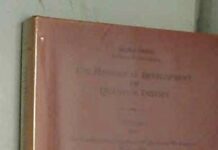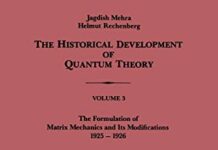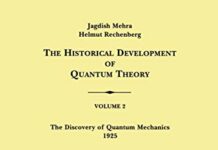
Ebook Info
- Published: 2003
- Number of pages: 696 pages
- Format: PDF
- File Size: 39.15 MB
- Authors: Jagdish Mehra
Description
This is the first biography ever written on the distinguished physicist Julian Schwinger. Schwinger was one of the most important and influential scientists of the twentieth century. The list of his contributions is staggering, from his early work leading to the Schwinger action principle, Euclidean quantum field theory, and the genesis of the standard model, to later valuable work on magnetic charge and the Casimir effect. He also shared the 1965 Nobel Prize in Physics with Richard Feynman. However, even among physicists, understanding and recognition of his work remains limited. This book by Mehra and Milton, both of whom were personally acquainted with Schwinger, presents a unique portrait that sheds light on both his personality and his work through discussion of his lasting influence on science. Anyone who wishes to gain a deeper understanding of one of the great physicists of this century needs to read this book.
User’s Reviews
Reviews from Amazon users which were colected at the time this book was published on the website:
⭐This book was sick. A really really good look into one of the greatest minds. Just about as much physics as there is history in it so the average physicist will have a ball reading it. I personally loved the perspective that it gave with how physics is approached from within the theoretical community. It really gave humanity to some of the heavy weights of the 20th century; with how the ideas were developed, how personal issues effected the outcomes of certain events, and how Julian Schwinger took on the monumental task (alone and in the middle of the night) one of man kinds greatest achievements of mankind: the formulation and execution of QED.
⭐I have come to realize that I will forever remain unsatisfied with “scientific” biographies, because the only one that has yet to impress me is Pais’ Subtle Is The Lord: The Life and Science of Albert Einstein (Oxford). Jagdish Mehra previously penned a “scientific” biography of Richard Feynman: Beat Of A Different Drum (Oxford, 1994). It, too, was full of detail. The writing was opaque and it included much detail, so much so that the reader could not “see the forest for the trees.” Unfortunately, this Schwinger biography replicates that undesirable quality: an inability to follow the big picture due to the enormous amount of extraneous detail. I confess this biography is better-written than the Feynman biography. Before reading this book, I heartily recommend reading: Schwinger, The Physicist, The Teacher and The Man (1996, World Scientific). Let us explore further:(1) First, a quibble regarding a footnote: “Richard Feynman told Jagdish Mehra that he wanted to see and interact with Schwinger as much as possible, this, a week before his passing. Feynman stated “But, here we are, within ten miles of each other, and in spite of numerous overtures, we don’t meet. It has been a source of much regret to me.” (page 611). Mehra and Kimball write: It was Schwinger’s extreme shyness in reaching out to people that kept him apart from even Feynman. Now, that comment by Feynman should not be relegated to a mere footnote (near the conclusion of the book) and is vacuously explained away by Mehra and Milton by highlighting Julian Schwinger‘s extreme shyness !(2) Another quibble, read: “Schwinger’s final journal contribution to graviton physics was a short paper he submitted to the Gravity Research Foundation. It received the second prize for 1975.” (page 512). Mehra and Milton write no more of this paper (see page 508). Happily, you can download a copy of that 5-page paper and read what Schwinger had to say ! It is a fascinating paper, get it and read it ! Schwinger’s 1965 Nobel lecture “Relativistic Quantum Field Theory” can be read online separate from this biography.(3) Mehra and Milton write: “Schwinger’s legacy of a phenomenological approach to particle physics lives on in the mainstream ideology, who no longer recognizes its source.” (page 478). Richard Arnowitt says: “Schwinger did many things he is not credited for, for example, the Bethe-Salpeter equation.” (page 324). Schwinger gave the first proof of the TCP theorem (Pauli published three years after). Mehra and Milton write: “Schwinger was never given any credit for this early work.” (page 382). As of year 2000 (publication date) that may have been true (neglect in crediting the work of Schwinger). But, now, the physics preprint database (arXiv) for the year 2019, finds Schwinger’s name everywhere ! That is, 103 results from January to April 2019. ‘Google scholar’ locates more than 2000 citations to Schwinger (for one year 2019). Schwinger is now given much recognition. In short, Julian Schwinger was far ahead of his time !(4) This biography of Julian Schwinger extends to 650 pages. There are two appendices. One appendix is a publications list of 231 items. Another is a list of Schwinger’s PhD students. There is a subject index and a separate index of names. References follow each chapter. Footnotes occur often.(5) Harvard University held a centennial celebration for Schwinger, February 2018: Memories of Julian. Videos are available on the Harvard physics department website. Learn of The Julian Schwinger Research Foundation: “we would like to help those people whose research is promising but not mainstream.” Read: “Julian Schwinger detested quantum chromodynamics.” (page 15, Physics Today, Vol. 56, No. 5, 2003).(6) A review by Cao is accurate: “There are too many quotations and summaries, and too few analyses and judgments, which turns hundreds of pages into a simple chronicle of events and publications.” (Physics Today, Vol. 55, No. 4, 2002). Cao concludes: “On the whole, the book does shed light on a many-faceted genius.” (Also, accurate).(7) Light that is shed: “Schwinger considered the problem of measurement in quantum mechanics as a nonexistent problem.” (page 369). “Schwinger’s approach to quantum mechanics was through Stern-Gerlach. He says, “the raw data to me was the Stern-Gerlach experiment.” (page 343) and, his greatest paper is generally considered to be “On Gauge Invariance and Vacuum Polarization (1950), which is an “exploitation of the Euler-Gamma function.” (page 309). Schwinger‘s teaching style: “he taught without referring to notes.” (page 157). Schwinger, learn, received an F in chemistry (page 27). Although we learn that trivia, it is not evident if he actually deserved an F, or, if the instructor was unable to understand how Schwinger arrived at answers. Schwinger’s student, Walter Kohn, received 1998 Nobel prize in chemistry ! Read, too: “Dirac’s book was my bible” (page 10). Apparently, Schwinger read Dirac at age 13. (page 6).(8) Learn of waveguides: “confine the field to prevent energy loss” (page 105), source theory: “correlations between fields” (page 457) and magnetic monopoles, where read: “The relativistic quantum field theory of magnetic and electric charge is of such beauty that we must repeat after Dirac, one would be surprised if nature had made no use of it.” (page 405). Also, action principles: “extending the stationary principles of mechanics.” (page 315, chapter nine).(9) Concluding: I have only begun to scratch the surface. There is overwhelming surfeit of detail. That is a blessing and a curse. Bryce DeWitt (a student) is quoted early (page 157) and later (page 593). But, these are virtually identical quotes on each page (thus, a repetition of identical material). Equations confronting the reader will be meaningless unless you already know the punchline (e.g., page 14: the uninitiated will learn nothing by the meaningless string of symbols displayed–there being no distinction made between symbols representing operators, state vectors, scalars, vectors, matrices). And so, Julian Schwinger’s own writings are the best method to learn of Julian Schwinger’s accomplishments.
⭐This book should be required reading for every physicist and every physics student. While the technical material can be tough going, it can be skipped over, and there is much personal history to interest the lay reader. Schwinger’s accomplishments were not just comparable to Feynman’s; they were much greater. Only by reading this book can one appreciate all that he did, including anticipating electroweak unification, introducing the Higgs mechanism, and proving the spin-statistics theorem. Most importantly, he perfected Quantum Field Theory (his third trip “up the mountain”). The tragedy is that, like most of Schwinger’s work, QFT has been abandoned and forgotten – at least in its true meaning of a world made of fields – leaving the world to drown in a sea of chaos caused by the particle picture. As I show in my book for the lay reader [ASIN:0473179768 Fields of Color: The theory that escaped Einstein], which is dedicated in part to the memory of Julian Schwinger, only QFT can resolve the paradoxes of relativity and quantum mechanics that arise from the particle view.
⭐80 bucks for the Kindle edition? Notify me when they’ve come to their senses.
⭐many +’s
Keywords
Free Download Climbing the Mountain: The Scientific Biography of Julian Schwinger 1st Edition in PDF format
Climbing the Mountain: The Scientific Biography of Julian Schwinger 1st Edition PDF Free Download
Download Climbing the Mountain: The Scientific Biography of Julian Schwinger 1st Edition 2003 PDF Free
Climbing the Mountain: The Scientific Biography of Julian Schwinger 1st Edition 2003 PDF Free Download
Download Climbing the Mountain: The Scientific Biography of Julian Schwinger 1st Edition PDF
Free Download Ebook Climbing the Mountain: The Scientific Biography of Julian Schwinger 1st Edition




